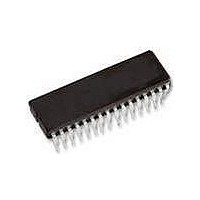TEA6360TD-T NXP Semiconductors, TEA6360TD-T Datasheet - Page 5

TEA6360TD-T
Manufacturer Part Number
TEA6360TD-T
Description
Audio Amplifiers FIVE-BAND EQUALIZER
Manufacturer
NXP Semiconductors
Datasheet
1.TEA6360TV2512.pdf
(15 pages)
Specifications of TEA6360TD-T
Product
General Purpose Audio Amplifiers
Maximum Operating Temperature
+ 85 C
Mounting Style
SMD/SMT
Minimum Operating Temperature
- 40 C
Package / Case
SOT-287
Lead Free Status / RoHS Status
Lead free / RoHS Compliant
Other names
TEA6360T/V2,518
Philips Semiconductors
FUNCTIONAL DESCRIPTION
The TEA6360 is performed with two stereo channels
(RIGHT and LEFT), each one consists of five equal filter
amplifiers (Fig.1).
The centre frequencies for the different filters as well as
the bandwidth and the control ranges for boost and cut
depend on the external components. Each filter can have
different external components but for one definite pair of
filters the centre frequency as well as the control range for
boost and cut are the same. That means, they have
symmetrical curves for boost and cut.
The control range (maximum value in dB) is divided into
five steps and one extra step for the linear position.
At maximum gain of 12 dB the typical step resolution is
2.4 dB. The internal resistor chain of each filter amplifier is
optimized for 12 dB maximum gain. Therefore the typical
gain factors for 15 dB application are as follows:
The control of the different filters is obtained by selecting
the appropriate subaddress byte (Table 1).
LIMITING VALUES
In accordance with the Absolute Maximum System (IEC 134).
Ground pins 19, 28 and 43 connected together.
Note
1. Equivalent to discharging a 200 pF capacitor through a 0
May 1991
step 1
step 2
step 3
step 4
step 5
V
V
P
T
T
V
SYMBOL
stg
amb
P
n
tot
ESD
5-band stereo equalizer circuit
= 2.7
= 5.5
= 8.4
= 11.6
= 15.0
supply voltage (pin 14)
voltage on all pins, grounds excluded
total power dissipation
storage temperature range
storage temperature range
operating ambient temperature range
electrostatic handling
dB
dB
dB
dB
dB
(1)
for all pins
PARAMETER
5
The position of the filter in the left channel and that in the
right channel is always the same (stereo).
The position of the boost part and the cut part is
independently controllable (Tables 2 and 3).
The quality factor of the filter has its maximum in the
maximum position (steps 5), if boost (cut on step 0) or cut
(boost on step 0) is used. The quality factor decreases also
with the step number (variable quality factor).
In this mode the control pattern are according to Table 4.
A different control is necessary to achieve a constant
quality factor over the whole control range. For boost with
a constant quality factor over the boost range position 5
is selected and boost control is then performed using cut.
This control technique is applied to the cut range with
position 5 selected and the boost is varied (Table 5).
The cut part has to follow the boost part in each filter for
economic reasons. So the signal is first amplified and then
attenuated. This has to be taken into account for the
internal level diagram in case of constant quality factor.
This may result in a mode between constant Q and
non-constant Q mode; for example for the position 2 it is
not necessary to amplify by step 5 and then attenuate by
position 2 is a good result (quasi constant quality factor,
Table 6).
3 step. The combination of step 4 and step 2 to reach
series resistor.
0
0
0
40
40
40
MIN.
13.2
V
500
150
150
85
500
P
Preliminary specification
MAX.
TEA6360
V
V
mW
V
C
C
C
UNIT














